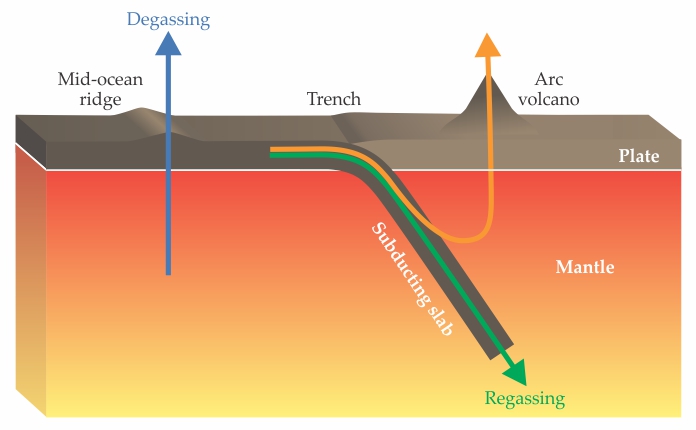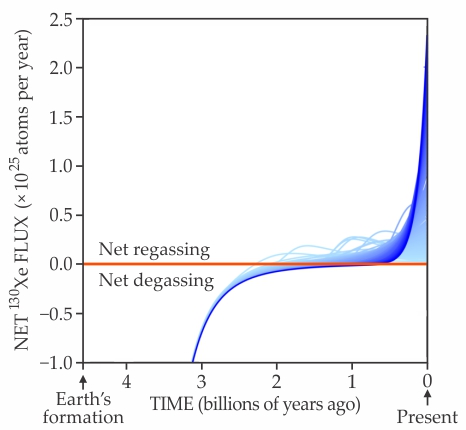Xenon isotopes tell the story of volatile recycling in the mantle
DOI: 10.1063/PT.3.4035
The water that cycles through Earth’s oceans, lakes, and atmosphere is just a portion of the water on this planet. A vast amount of water—as much as 2.5 times the mass of all surface reservoirs—is dispersed, molecule by molecule, in the mantle, where it influences mineral material properties and thus geological dynamics (see the article by Marc Hirschmann and David Kohlstedt, Physics Today, March 2012, page 40
On time scales of millions to billions of years, the water cycle includes exchanges into and out of the mantle, as illustrated in figure
Figure 1.

Pathways for volatiles. Water, xenon, and other volatile substances are degassed from the mantle through hot-spot volcanoes and mid-ocean ridges. They’re returned through subducting slabs: Whatever isn’t expelled from the slab and returned to the atmosphere through arc volcanoes is regassed into the deep mantle.

With volatiles moving in and out of the mantle, the density and makeup of the atmosphere and hydrosphere could conceivably have changed significantly over geologic time. Yet life has existed continuously on Earth for most of the planet’s history. Despite mass extinctions and dramatic transformations in the nature of living things, conditions on Earth—unlike those on, say, the Moon or Venus—have always been suitable for organisms of some form. Understanding the history of volatile recycling is an important part of understanding Earth’s past and present habitability.
Now Rita Parai (Washington University in St Louis) and Sujoy Mukhopadhyay (University of California, Davis) have established the first quantitative constraints on how the mantle–surface volatile exchange evolved over time. 1 They numerically modeled the degassing and regassing of xenon, a rare gas that nonetheless can be a powerful tracer of more abundant volatiles.
Water-bearing minerals, in particular, all carry some Xe. Because the Xe-to-water ratio varies, it’s not usually possible to derive a detailed quantitative relationship between Xe fluxes and water fluxes. But if, for a particular time and place, the deep Xe flux is zero, then the deep water flux is likely to be as well. The researchers found from their model that for much of Earth’s early history, Xe—and thus water—moved only out of the mantle, not back into it.
Tracking isotopes
Xenon has nine stable isotopes; all are present on Earth, but their local relative abundances are not fixed. Atmospheric Xe has grown progressively heavier over time, probably due to the selective escape of the lighter isotopes into space, although the details of the mechanism remain unknown. As trapped samples of ancient air reveal, the change was smooth and steady from early in Earth’s history until 2 billion years ago; since then, the isotopic composition of Xe in the atmosphere has been constant. 2
Meanwhile, processes in the mantle have also driven isotopic change. Five of the nine Xe isotopes are radiogenic, produced in characteristic amounts by the decay of iodine-129 and fission of plutonium-244 and uranium-238. Whereas 129I and 244Pu were present in early Earth but have long gone extinct, 238U is still in the mantle and producing Xe.
The Xe in the mantle today—whose composition is known from analysis of erupted basalts—is a mixture of Xe from five sources: the primordial Xe that’s been in the mantle since its formation (as inferred from chondritic meteorites, which largely preserve the initial composition of the solar system), the three Xe-producing radioisotopes, and atmospheric Xe regassed into the mantle. If the atmospheric isotopic composition had been constant over time, one could figure out how much each source contributed to the mantle by solving a system of nine linear equations (one for each isotope) in five variables (one for each source). In general, such an overdetermined system of equations doesn’t always admit a solution—but if it’s an accurate description of a physical phenomenon, it does.
Parai and Mukhopadhyay recognized that they could solve the equations if they assumed that all the regassed Xe came from an atmosphere with a modern isotopic composition. (In practice, they left out several isotopes and the 129I fission source, but they still had an overdetermined linear system.) If they assumed that an ancient atmosphere was the source of the regassed Xe, however, the equations had no solution. 3 That simple test was a first hint that regassing had grown stronger over time.
Testing histories
To probe the idea more rigorously, the researchers developed a numerical model that could simulate the mantle’s Xe dynamics over time. They started with a mantle of chondritic composition; at each time step, some Xe is degassed, some is regassed, and some is produced through radioactivity. The mantle was assumed to be well mixed, so the degassed Xe had the same isotopic composition as the mantle as a whole. For the regassed Xe, the researchers used the known time-dependent atmospheric composition.
The degassing and regassing rates were hypothesized. Parai ran the simulation many times, each with a different regassing history randomly chosen from a parameter space of functional forms. Histories that correctly reproduced the Xe concentration and composition in the present-day mantle were deemed successful; figure
Figure 2.

Histories of xenon regassing that successfully reproduced today’s mantle Xe composition. Shown here is the net Xe flux into the mantle: the regassing rate minus the degassing rate. Although it’s not evident from the figure, all of the successful histories show essentially no regassing at all prior to 2.5 billion years ago. (Adapted from ref.

As the figure shows, Earth began in a state of net degassing, with more Xe leaving the mantle than entering it. Sometime between 2.5 billion years ago and several hundred million years ago, it switched to a regime of net regassing. Many of the successful histories show a sharp increase in the regassing rate over the past few hundred million years, but that late rise doesn’t necessarily represent a physical phenomenon. “The approach we took was to find everything that’s possible,” says Parai, “so we can’t figure out relative probabilities among the workable scenarios.” Any of the successful histories with earlier rise times and low present-day regassing rates are also possible.
But there was one stark result: None of the successful histories had any significant Xe regassing prior to 2.5 billion years ago. “We were surprised by how little early regassing could be tolerated,” says Parai. “We suspected that the amount might be limited, but we had no idea how much until we did the computations.”
If Xe regassing was limited until 2.5 billion years ago, then water regassing was as well. That’s especially curious because of evidence that plate tectonics, and therefore subduction, has been going on for at least 3 billion years. 4 If that’s true, then for hundreds of millions of years, subducting slabs were being returned from the crust to the mantle, but they carried no water at all. Maybe their volatiles were efficiently expelled in the process of subduction—Parai and Mukhopadhyay’s model counts volatiles as being regassed only when they make it deep enough into the mantle to be well mixed. Or maybe the ancient crust wasn’t hydrated to begin with.
Geologists consider 2.5 billion years ago to be the boundary between the Archean and Proterozoic eons, and a number of important changes happened at approximately that time. Most notable among them, perhaps, was the first accumulation of oxygen in Earth’s atmosphere (see Physics Today, June 2018, page 16
References
1. R. Parai, S. Mukhopadhyay, Nature 560, 223 (2018). https://doi.org/10.1038/s41586-018-0388-4
2. G. Avice et al., Geochim. Cosmochim. Acta 232, 82 (2018). https://doi.org/10.1016/j.gca.2018.04.018
3. R. Parai, S. Mukhopadhyay, Geochem. Geophys. Geosyst. 16, 719 (2015). https://doi.org/10.1002/2014GC005566
4. S. B. Shirey, S. H. Richardson, Science 333, 434 (2011). https://doi.org/10.1126/science.1206275
